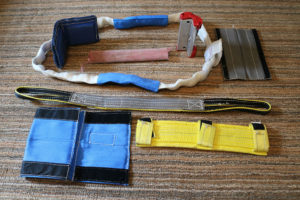 Written by Dave Decker, President, Becket Training & Consulting in Crane and Rigging Hotline
Written by Dave Decker, President, Becket Training & Consulting in Crane and Rigging Hotline
Most riggers will tell you that you never rig a synthetic sling over a sharp edge. But is that enough? All slings can be damaged, and damaged slings can fail suddenly and without warning.
So, what can we do to be sure that our slings are protected from damage?
Industry standard, ASME B30.9 Slings, provides performance-based criteria for sling protection in each sling chapter and requires adequate protection to prevent sling damage which may lead to catastrophic failure.
The Web Sling & Tie Down Association (WSTDA) publishes recommended standard specifications WSTDA-RS-1 for Roundslings, WSTDA-RS-1HP for High Performance Roundslings and WSTDA-WS-1 for Web Slings. Each of the WSTDA standards offers recommendations for sling protection.
Understanding sling protection
To fully understand sling protection, we must consider the type of damage a particular sling is susceptible to. The risk of damage to a chain sling can be very different than the risk to a webbing sling, but all slings can be damaged if they are not adequately protected.
The sling protectors must be appropriate to both the type of sling and the load. The sling protector may be required to prevent abrasion of the sling, to prevent the sling from cutting, or to protect the load from damage from the sling. When it comes to sling protection, one size, or type, does not fit all.
A synthetic sling in-tension has a much greater risk of damage than a sling at rest. You may have seen a rigger feel the edge of a load to see if it was sharp. The logic being that if the edge does not feel sharp to the touch it will not damage the sling. They could be dead wrong!
The edge may not feel sharp given our relatively light touch, but when a sling is supporting a load, there is a tremendous amount of force applied to the sling over the edges of the load. Think of the edge of the load as a dull knife. You might rub your finger over the blade and not cut yourself. But if you put enough pressure on the blade it will cut you no matter how dull the blade.
When a sling moves along an edge due to load-shifting, the risk of cutting is increased. Load-shifting may also result in unexpected contact with a damaging surface and must be considered.
Most synthetic slings are susceptible to melting at relatively low temperatures. Therefore, synthetic slings rigged over relatively smooth surfaces can fail due to heat generated by friction if the slings move on the load even a few inches.
So how do we protect slings from damage? The simple answer is to put a protective barrier between the slings and the load and rig to prevent load shifting whenever possible.
In an ideal world we would have a complete inventory of sling protection devices. Many construction and manufacturing companies make their own sling protectors on-site for the particular jobs they do. This is a perfectly acceptable method if the devices provide adequate sling protection.
Sling protection is your responsibility
There are currently no requirements dictating how a sling must be protected. The responsibility for adequate sling protection falls on the user. Over the years, I have seen everything from firehose and leather gloves to pizza boxes used in an attempt to provide some level of sling protection. While any sling protection is arguably better than no sling protection, it makes little difference if the sling ultimately fails due to lack of adequate protection.
While there is no prescriptive requirement telling us how to protect the slings, a proper lift plan should prescribe sling protection to be used including type and placement.
Available sling protection devices
Some manufacturers offer load-rated sling protection giving the rigger additional information to help determine the best protection for the sling in the application at hand.
Sling manufacturers offer pre-made sling protection devices. Available commercial sling protection is made from a variety of materials such as aramid fibers or High-Modulus Polyethylene (HMPE), nylon, plastics, aluminum or steel. Many sling protectors are made from a combination of two or more materials.
Some sling manufacturers will attach permanent sling protection to the sling upon request. Permanent sling protection may be a layer of aramid or HMPE webbing sewn over a nylon or polyester webbing sling designed to protect the sling from cutting. Protection installed on a roundsling could be a sliding sleeve designed to provide abrasion resistance at the bearing point such a hook or shackle.
Sling manufacturers will often be able to offer guidance on selecting slings and sling protection devices that are appropriate for the type of lifting you perform.
Whenever you use synthetic slings, remember: All slings require protection when exposed to edges or abrasive surfaces. Failure to properly protect slings during a lift is a poor bet. Don’t bet with your life!